Report: HRM Practices, Leadership Styles, and Syngenta Case Study
VerifiedAdded on 2021/04/21
|7
|1426
|27
Report
AI Summary
This report provides a comprehensive analysis of Syngenta's human resource management (HRM) practices. It begins by examining the company's flat organizational structure and its implications for employee involvement and motivation, emphasizing the role of managers in providing training and rewards. The report then explores the application of Charles Handy's model, specifically task and role cultures, within Syngenta, highlighting how these contribute to innovation and market demand. Furthermore, it delves into the company's use of democratic leadership, discussing its impact on employee engagement and the importance of incorporating employee feedback. Finally, the report outlines key HRM functions, including reward management and training and development, emphasizing their significance in fostering employee motivation, skill enhancement, and overall organizational success. The conclusion reiterates the importance of training and development for employees and attractive incentives for employees to maintain equality and retain the employees in the organization for a long time.
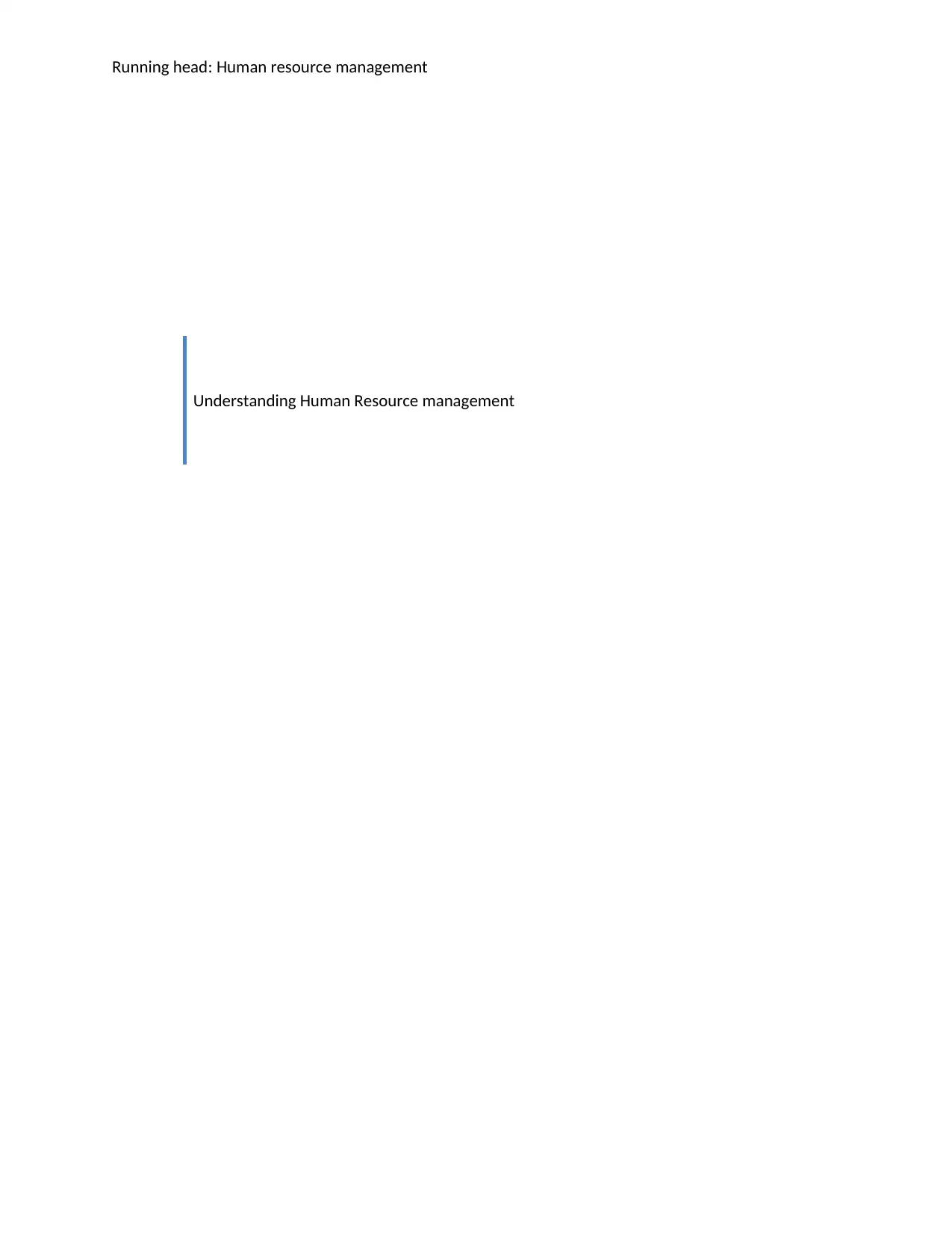
Running head: Human resource management
Understanding Human Resource management
Understanding Human Resource management
Paraphrase This Document
Need a fresh take? Get an instant paraphrase of this document with our AI Paraphraser
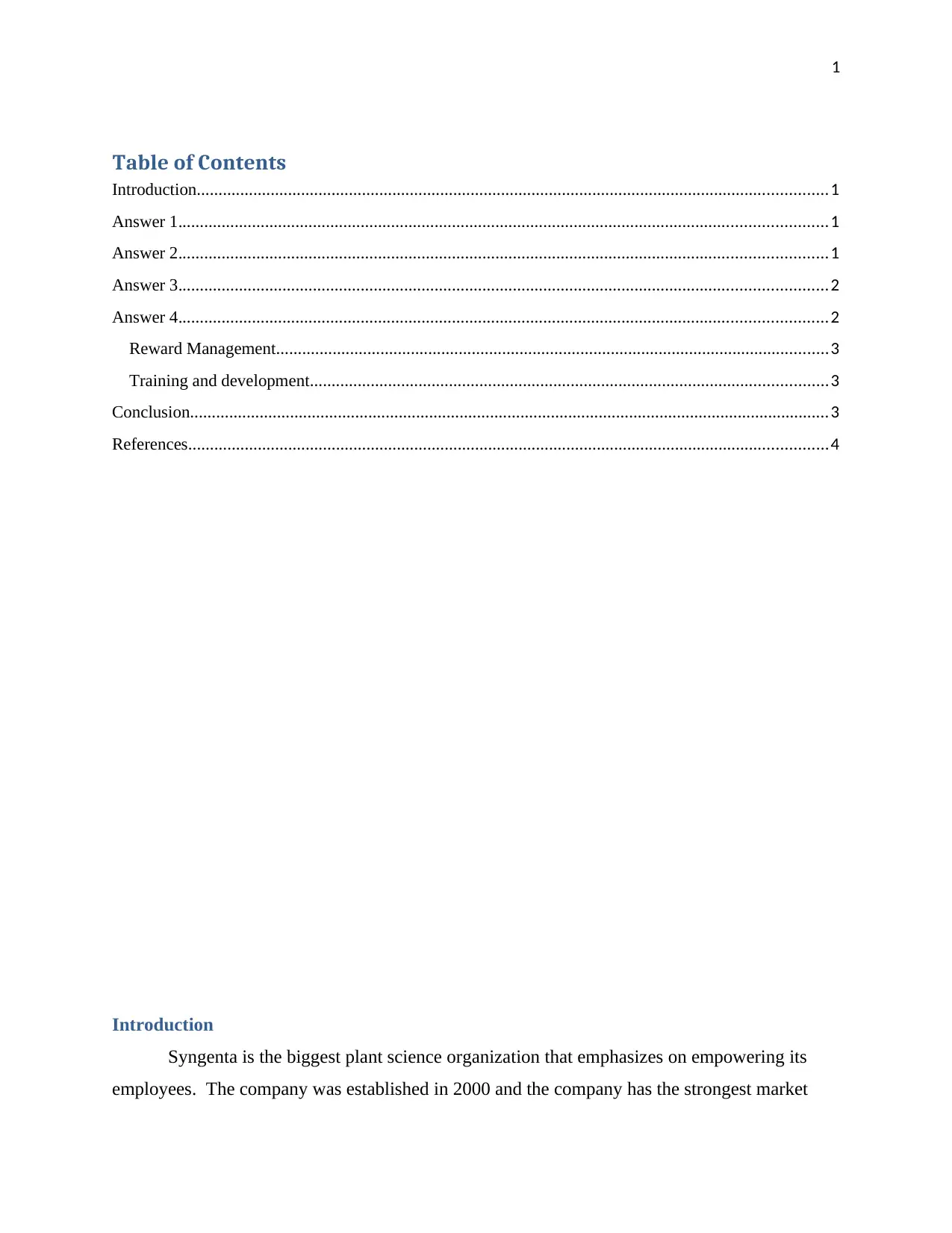
1
Table of Contents
Introduction.................................................................................................................................................1
Answer 1.....................................................................................................................................................1
Answer 2.....................................................................................................................................................1
Answer 3.....................................................................................................................................................2
Answer 4.....................................................................................................................................................2
Reward Management...............................................................................................................................3
Training and development.......................................................................................................................3
Conclusion...................................................................................................................................................3
References...................................................................................................................................................4
Introduction
Syngenta is the biggest plant science organization that emphasizes on empowering its
employees. The company was established in 2000 and the company has the strongest market
Table of Contents
Introduction.................................................................................................................................................1
Answer 1.....................................................................................................................................................1
Answer 2.....................................................................................................................................................1
Answer 3.....................................................................................................................................................2
Answer 4.....................................................................................................................................................2
Reward Management...............................................................................................................................3
Training and development.......................................................................................................................3
Conclusion...................................................................................................................................................3
References...................................................................................................................................................4
Introduction
Syngenta is the biggest plant science organization that emphasizes on empowering its
employees. The company was established in 2000 and the company has the strongest market
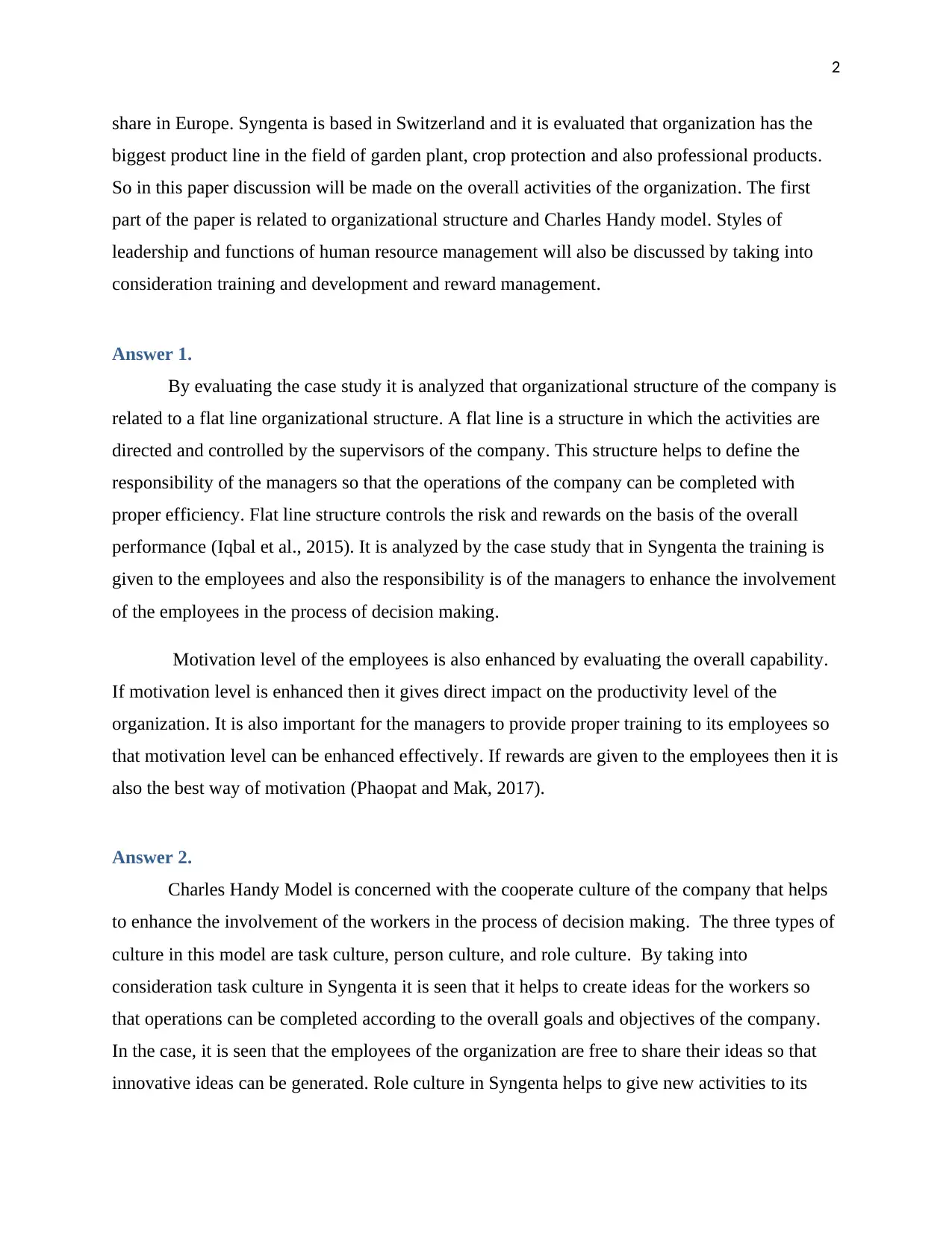
2
share in Europe. Syngenta is based in Switzerland and it is evaluated that organization has the
biggest product line in the field of garden plant, crop protection and also professional products.
So in this paper discussion will be made on the overall activities of the organization. The first
part of the paper is related to organizational structure and Charles Handy model. Styles of
leadership and functions of human resource management will also be discussed by taking into
consideration training and development and reward management.
Answer 1.
By evaluating the case study it is analyzed that organizational structure of the company is
related to a flat line organizational structure. A flat line is a structure in which the activities are
directed and controlled by the supervisors of the company. This structure helps to define the
responsibility of the managers so that the operations of the company can be completed with
proper efficiency. Flat line structure controls the risk and rewards on the basis of the overall
performance (Iqbal et al., 2015). It is analyzed by the case study that in Syngenta the training is
given to the employees and also the responsibility is of the managers to enhance the involvement
of the employees in the process of decision making.
Motivation level of the employees is also enhanced by evaluating the overall capability.
If motivation level is enhanced then it gives direct impact on the productivity level of the
organization. It is also important for the managers to provide proper training to its employees so
that motivation level can be enhanced effectively. If rewards are given to the employees then it is
also the best way of motivation (Phaopat and Mak, 2017).
Answer 2.
Charles Handy Model is concerned with the cooperate culture of the company that helps
to enhance the involvement of the workers in the process of decision making. The three types of
culture in this model are task culture, person culture, and role culture. By taking into
consideration task culture in Syngenta it is seen that it helps to create ideas for the workers so
that operations can be completed according to the overall goals and objectives of the company.
In the case, it is seen that the employees of the organization are free to share their ideas so that
innovative ideas can be generated. Role culture in Syngenta helps to give new activities to its
share in Europe. Syngenta is based in Switzerland and it is evaluated that organization has the
biggest product line in the field of garden plant, crop protection and also professional products.
So in this paper discussion will be made on the overall activities of the organization. The first
part of the paper is related to organizational structure and Charles Handy model. Styles of
leadership and functions of human resource management will also be discussed by taking into
consideration training and development and reward management.
Answer 1.
By evaluating the case study it is analyzed that organizational structure of the company is
related to a flat line organizational structure. A flat line is a structure in which the activities are
directed and controlled by the supervisors of the company. This structure helps to define the
responsibility of the managers so that the operations of the company can be completed with
proper efficiency. Flat line structure controls the risk and rewards on the basis of the overall
performance (Iqbal et al., 2015). It is analyzed by the case study that in Syngenta the training is
given to the employees and also the responsibility is of the managers to enhance the involvement
of the employees in the process of decision making.
Motivation level of the employees is also enhanced by evaluating the overall capability.
If motivation level is enhanced then it gives direct impact on the productivity level of the
organization. It is also important for the managers to provide proper training to its employees so
that motivation level can be enhanced effectively. If rewards are given to the employees then it is
also the best way of motivation (Phaopat and Mak, 2017).
Answer 2.
Charles Handy Model is concerned with the cooperate culture of the company that helps
to enhance the involvement of the workers in the process of decision making. The three types of
culture in this model are task culture, person culture, and role culture. By taking into
consideration task culture in Syngenta it is seen that it helps to create ideas for the workers so
that operations can be completed according to the overall goals and objectives of the company.
In the case, it is seen that the employees of the organization are free to share their ideas so that
innovative ideas can be generated. Role culture in Syngenta helps to give new activities to its
⊘ This is a preview!⊘
Do you want full access?
Subscribe today to unlock all pages.

Trusted by 1+ million students worldwide
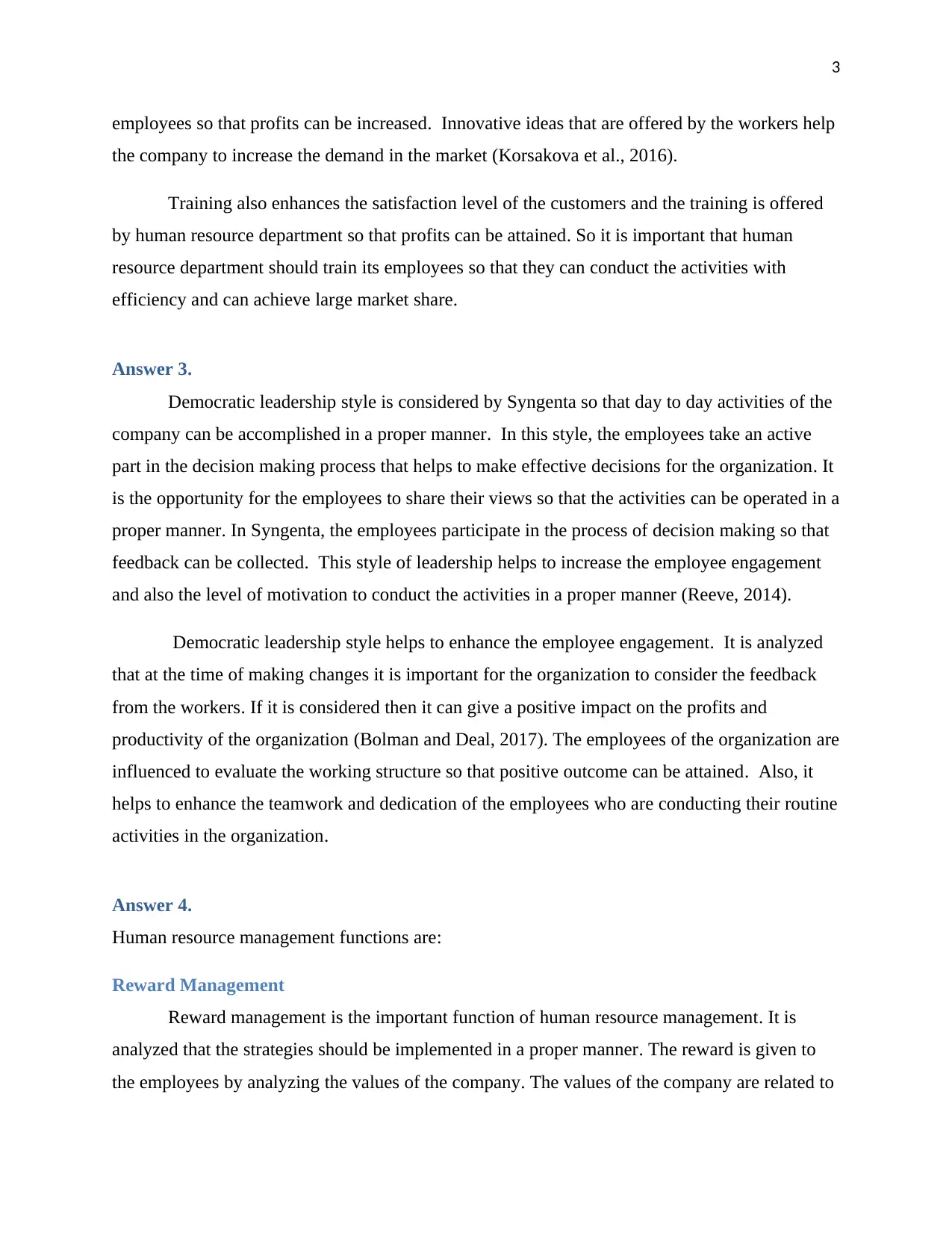
3
employees so that profits can be increased. Innovative ideas that are offered by the workers help
the company to increase the demand in the market (Korsakova et al., 2016).
Training also enhances the satisfaction level of the customers and the training is offered
by human resource department so that profits can be attained. So it is important that human
resource department should train its employees so that they can conduct the activities with
efficiency and can achieve large market share.
Answer 3.
Democratic leadership style is considered by Syngenta so that day to day activities of the
company can be accomplished in a proper manner. In this style, the employees take an active
part in the decision making process that helps to make effective decisions for the organization. It
is the opportunity for the employees to share their views so that the activities can be operated in a
proper manner. In Syngenta, the employees participate in the process of decision making so that
feedback can be collected. This style of leadership helps to increase the employee engagement
and also the level of motivation to conduct the activities in a proper manner (Reeve, 2014).
Democratic leadership style helps to enhance the employee engagement. It is analyzed
that at the time of making changes it is important for the organization to consider the feedback
from the workers. If it is considered then it can give a positive impact on the profits and
productivity of the organization (Bolman and Deal, 2017). The employees of the organization are
influenced to evaluate the working structure so that positive outcome can be attained. Also, it
helps to enhance the teamwork and dedication of the employees who are conducting their routine
activities in the organization.
Answer 4.
Human resource management functions are:
Reward Management
Reward management is the important function of human resource management. It is
analyzed that the strategies should be implemented in a proper manner. The reward is given to
the employees by analyzing the values of the company. The values of the company are related to
employees so that profits can be increased. Innovative ideas that are offered by the workers help
the company to increase the demand in the market (Korsakova et al., 2016).
Training also enhances the satisfaction level of the customers and the training is offered
by human resource department so that profits can be attained. So it is important that human
resource department should train its employees so that they can conduct the activities with
efficiency and can achieve large market share.
Answer 3.
Democratic leadership style is considered by Syngenta so that day to day activities of the
company can be accomplished in a proper manner. In this style, the employees take an active
part in the decision making process that helps to make effective decisions for the organization. It
is the opportunity for the employees to share their views so that the activities can be operated in a
proper manner. In Syngenta, the employees participate in the process of decision making so that
feedback can be collected. This style of leadership helps to increase the employee engagement
and also the level of motivation to conduct the activities in a proper manner (Reeve, 2014).
Democratic leadership style helps to enhance the employee engagement. It is analyzed
that at the time of making changes it is important for the organization to consider the feedback
from the workers. If it is considered then it can give a positive impact on the profits and
productivity of the organization (Bolman and Deal, 2017). The employees of the organization are
influenced to evaluate the working structure so that positive outcome can be attained. Also, it
helps to enhance the teamwork and dedication of the employees who are conducting their routine
activities in the organization.
Answer 4.
Human resource management functions are:
Reward Management
Reward management is the important function of human resource management. It is
analyzed that the strategies should be implemented in a proper manner. The reward is given to
the employees by analyzing the values of the company. The values of the company are related to
Paraphrase This Document
Need a fresh take? Get an instant paraphrase of this document with our AI Paraphraser
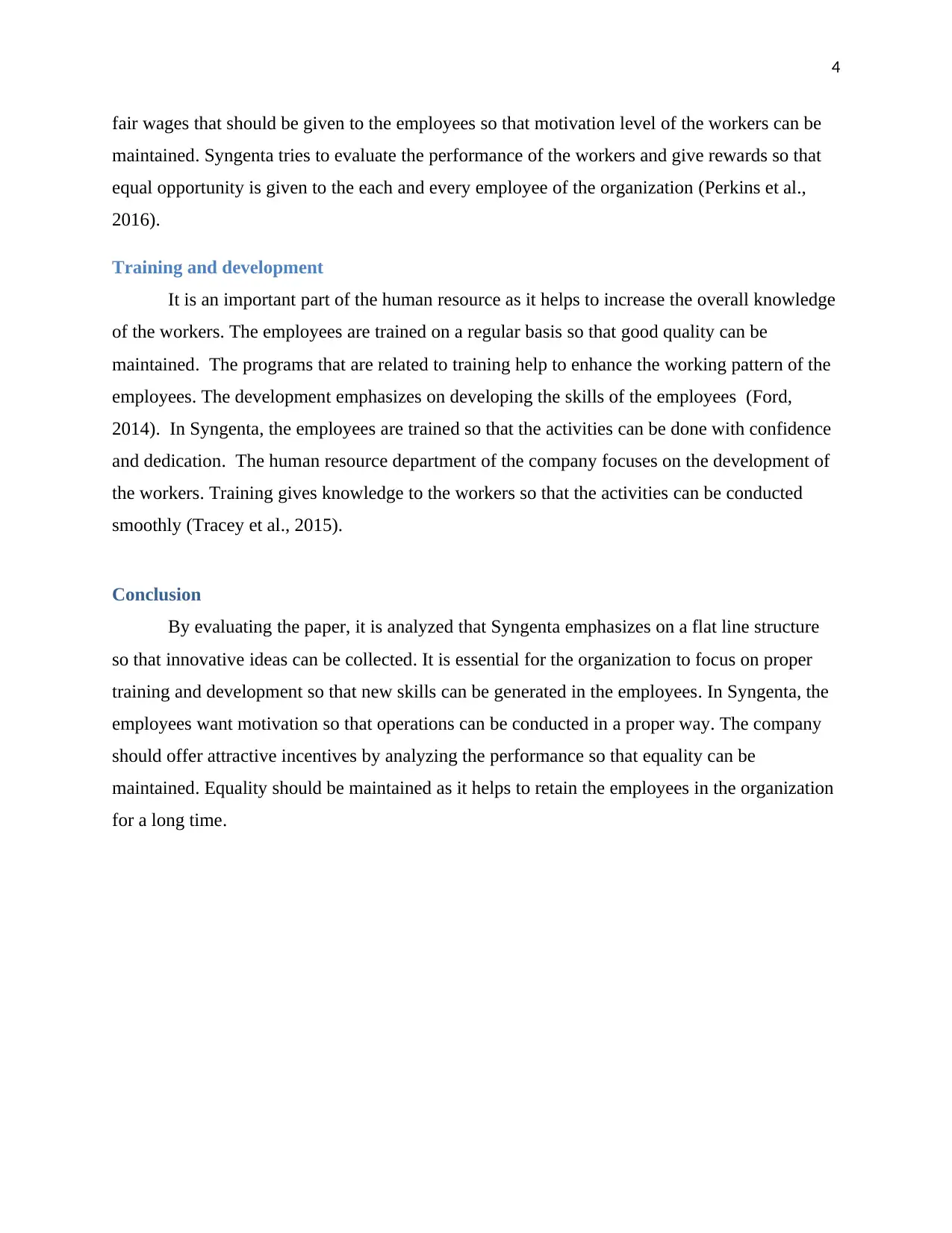
4
fair wages that should be given to the employees so that motivation level of the workers can be
maintained. Syngenta tries to evaluate the performance of the workers and give rewards so that
equal opportunity is given to the each and every employee of the organization (Perkins et al.,
2016).
Training and development
It is an important part of the human resource as it helps to increase the overall knowledge
of the workers. The employees are trained on a regular basis so that good quality can be
maintained. The programs that are related to training help to enhance the working pattern of the
employees. The development emphasizes on developing the skills of the employees (Ford,
2014). In Syngenta, the employees are trained so that the activities can be done with confidence
and dedication. The human resource department of the company focuses on the development of
the workers. Training gives knowledge to the workers so that the activities can be conducted
smoothly (Tracey et al., 2015).
Conclusion
By evaluating the paper, it is analyzed that Syngenta emphasizes on a flat line structure
so that innovative ideas can be collected. It is essential for the organization to focus on proper
training and development so that new skills can be generated in the employees. In Syngenta, the
employees want motivation so that operations can be conducted in a proper way. The company
should offer attractive incentives by analyzing the performance so that equality can be
maintained. Equality should be maintained as it helps to retain the employees in the organization
for a long time.
fair wages that should be given to the employees so that motivation level of the workers can be
maintained. Syngenta tries to evaluate the performance of the workers and give rewards so that
equal opportunity is given to the each and every employee of the organization (Perkins et al.,
2016).
Training and development
It is an important part of the human resource as it helps to increase the overall knowledge
of the workers. The employees are trained on a regular basis so that good quality can be
maintained. The programs that are related to training help to enhance the working pattern of the
employees. The development emphasizes on developing the skills of the employees (Ford,
2014). In Syngenta, the employees are trained so that the activities can be done with confidence
and dedication. The human resource department of the company focuses on the development of
the workers. Training gives knowledge to the workers so that the activities can be conducted
smoothly (Tracey et al., 2015).
Conclusion
By evaluating the paper, it is analyzed that Syngenta emphasizes on a flat line structure
so that innovative ideas can be collected. It is essential for the organization to focus on proper
training and development so that new skills can be generated in the employees. In Syngenta, the
employees want motivation so that operations can be conducted in a proper way. The company
should offer attractive incentives by analyzing the performance so that equality can be
maintained. Equality should be maintained as it helps to retain the employees in the organization
for a long time.
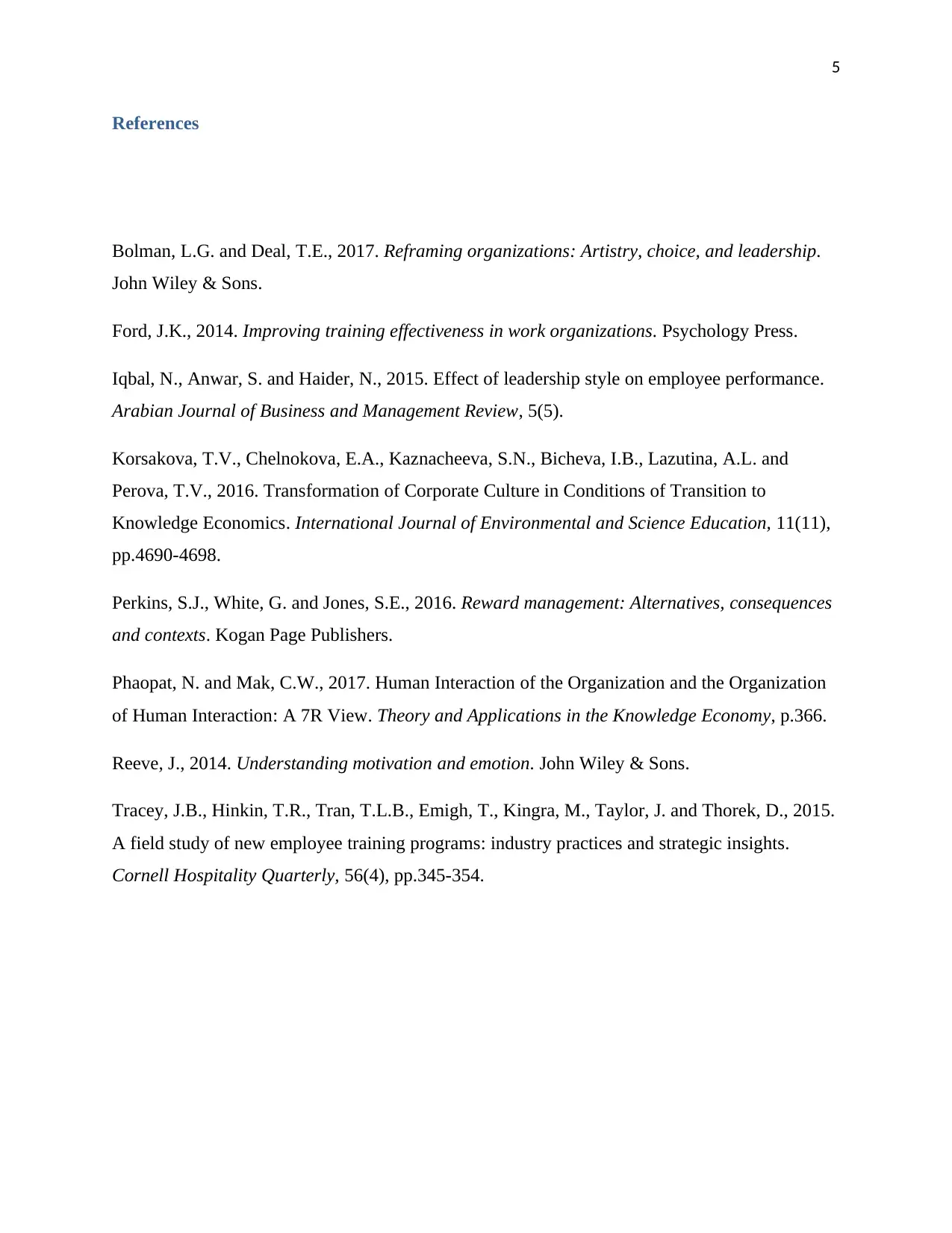
5
References
Bolman, L.G. and Deal, T.E., 2017. Reframing organizations: Artistry, choice, and leadership.
John Wiley & Sons.
Ford, J.K., 2014. Improving training effectiveness in work organizations. Psychology Press.
Iqbal, N., Anwar, S. and Haider, N., 2015. Effect of leadership style on employee performance.
Arabian Journal of Business and Management Review, 5(5).
Korsakova, T.V., Chelnokova, E.A., Kaznacheeva, S.N., Bicheva, I.B., Lazutina, A.L. and
Perova, T.V., 2016. Transformation of Corporate Culture in Conditions of Transition to
Knowledge Economics. International Journal of Environmental and Science Education, 11(11),
pp.4690-4698.
Perkins, S.J., White, G. and Jones, S.E., 2016. Reward management: Alternatives, consequences
and contexts. Kogan Page Publishers.
Phaopat, N. and Mak, C.W., 2017. Human Interaction of the Organization and the Organization
of Human Interaction: A 7R View. Theory and Applications in the Knowledge Economy, p.366.
Reeve, J., 2014. Understanding motivation and emotion. John Wiley & Sons.
Tracey, J.B., Hinkin, T.R., Tran, T.L.B., Emigh, T., Kingra, M., Taylor, J. and Thorek, D., 2015.
A field study of new employee training programs: industry practices and strategic insights.
Cornell Hospitality Quarterly, 56(4), pp.345-354.
References
Bolman, L.G. and Deal, T.E., 2017. Reframing organizations: Artistry, choice, and leadership.
John Wiley & Sons.
Ford, J.K., 2014. Improving training effectiveness in work organizations. Psychology Press.
Iqbal, N., Anwar, S. and Haider, N., 2015. Effect of leadership style on employee performance.
Arabian Journal of Business and Management Review, 5(5).
Korsakova, T.V., Chelnokova, E.A., Kaznacheeva, S.N., Bicheva, I.B., Lazutina, A.L. and
Perova, T.V., 2016. Transformation of Corporate Culture in Conditions of Transition to
Knowledge Economics. International Journal of Environmental and Science Education, 11(11),
pp.4690-4698.
Perkins, S.J., White, G. and Jones, S.E., 2016. Reward management: Alternatives, consequences
and contexts. Kogan Page Publishers.
Phaopat, N. and Mak, C.W., 2017. Human Interaction of the Organization and the Organization
of Human Interaction: A 7R View. Theory and Applications in the Knowledge Economy, p.366.
Reeve, J., 2014. Understanding motivation and emotion. John Wiley & Sons.
Tracey, J.B., Hinkin, T.R., Tran, T.L.B., Emigh, T., Kingra, M., Taylor, J. and Thorek, D., 2015.
A field study of new employee training programs: industry practices and strategic insights.
Cornell Hospitality Quarterly, 56(4), pp.345-354.
⊘ This is a preview!⊘
Do you want full access?
Subscribe today to unlock all pages.

Trusted by 1+ million students worldwide

6
1 out of 7
Related Documents
Your All-in-One AI-Powered Toolkit for Academic Success.
+13062052269
info@desklib.com
Available 24*7 on WhatsApp / Email
![[object Object]](/_next/static/media/star-bottom.7253800d.svg)
Unlock your academic potential
Copyright © 2020–2025 A2Z Services. All Rights Reserved. Developed and managed by ZUCOL.





